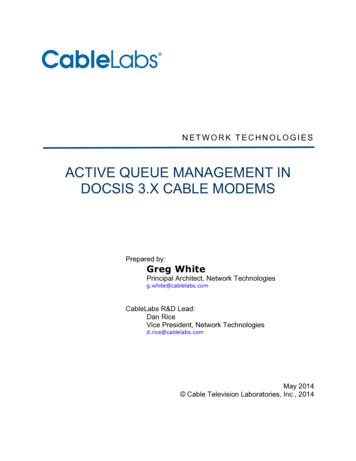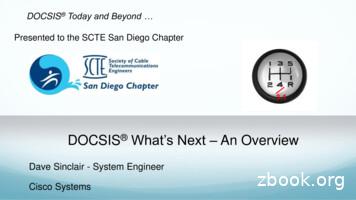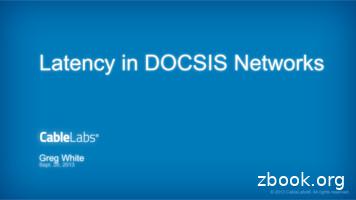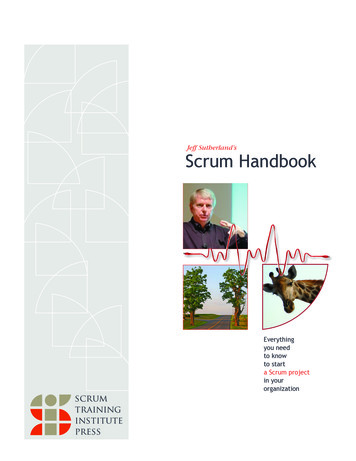DOCSIS 2.0 AND 3 - Budapest University Of Technology And .
DOCSIS 2.0 AND 3.0Presented by:M
AGENDA CURRENT STATUSDOCSIS 2.0M-CMTSDOCSIS 3.0Q&A
CURRENT STATUS Majority of MSOs in Caribbean and Latin America havedeployed DOCSIS services in some form If you are still on DOCSIS 1.0 you are in SEVERE risk oftheft of service. DOCSIS 1.1 is widely deployed but not all advantagesused.– QoS not being used for other application than voice.– Main driver were the security features of Docsis 1.1 Major MSOs on the region and new deployments alreadyusing DOCSIS 2.0.– Smaller node sizes– High bandwidth services. DOCSIS 3.0 services expected to blossom on 2010.
DOCSIS VERSIONSSpecInteropCertificationDOCSIS 1.0199719981999DOCSIS 1.11999Q3, 2000Q3, 2001DOCSIS 2.0Q4, 2001Q2, 2002Q4, 2002
DOCSIS 2.0
DOCSIS 2.0BENEFITS IN A NUTSHELL Increased return channel capacity New modulation techniques Better performance on noisy environmentsDownstream not changed nor improvedMAC layer not changed, only PHY layer.
DOCSIS 2.0 Higher return path RF BandwidthDOCSIS200 Khz400 Khz800 Khz1600 Khz3200 Khz6400 Khz1.0XXXXX1.1XXXXX2.0XXXXXX
DOCSIS 2.0IMPROVEMENTS ON SPECTRAL EFFICENCYBits per symbol1.X3.2 bits / Hertz QAM162.04.8 bits /Hertz 64QAM
DOCSIS 2.0NEW MODULATIONS A-TDMA: Evolution from DOCSIS 1.X TDMA– 8 QAM– 32 QAM– 64 QAM S-CDMA: New modulation format
DOCSIS 2.0 ATDMAHertzQPSK8 QAM16 QAM 32 QAM 64 QAM 602048025600307205120
DOCSIS 2.0 ATDMAIMPROVED PERFORMANCE UNDER INTERFERENCE Enhanced Pre-Ecualizer from 8 to 24 taps
DOCSIS 2.0 S-CDMASYNCHRONOUS CODE DIVISION MULTIPLE ACCESS Same throughput than ATDMA Better impulse noise performance under 20 Mhz Less latency Only useful on channels 1 Mhz Requires 10X better syncronization than ATDMA
DOCSIS 2.0 MIXED MODELogical ChannelsATDMA & TDMAS-CMDAThere’s a loss of performance close to 25% whenmixing ATDMA and SCDMA on the same RFChannel.There’s no loss by mixing ATDMA and TDMA
S-CDMA vs. A-TDMA Capacity Analysis
S-CDMA vs. A-TDMA Capacity AnalysisS-CDMA advantagesS-CDMA increase capacity up to 50%Enables 100 Mbps Upstream Service RatesDefer Node Splits
NETWORK REQUIREMENTSATDMASCDMAChannel SNR Required(dB)Modulation TypeChannel SNR Required(dB)Modulation AM
NETWORK REQUIREMENTS32QAM and 64QAM usually requires small node sizes. 1000 HHPP max N 1 or N 2 usually
M-CMTS
M-CMTS Goals “Independent scalability of CMTS functions from DS PHY”– Means: need to add DS channels without adding US channels “Lower the cost to deliver video over DOCSIS service tobe competitive with today’s MPEG VOD” 2005 Incremental DOCSIS DS channel cost: 24K ASP for2DS 8US CMTS blade 12, 000 per DS channel– 2005 Incremental MPEG VOD channel cost: 12K for 24-channelMPEG EQAM 500 per DS channel But with no rate limiting, scheduling, QOS, encryption, VOIP compression, or RFswitching
M-CMTS InterfacesTiming SignalGeneratorDOCSIS TimingInterface (DTI)DownstreamExternal-PhyInterface(DEPI)NSIWide AreaNetworkCable ModemTerminationSystemGeNew DS RFInterfaceCMCIEdge QAM("CMTS")HFC CableNetworkIntegratedUpstreamReceiversCable Modem("CM")RFIERMIOSSIDOCSIS OperationSupport SystemsRFSCIEdge ResourceManagerRF Switching ControlCustomerPremisesEquipment("CPE")
What’s important and not for MCMTS What’s important is that the two M-CMTS goals be met:- De-coupling downstream and upstream capacity; and- Lowering the cost of downstream capacity. What’s important is the adoption of the DEPI specification by theEQAM industry.– Enables a transition to DOCSIS IPTV with DEPI EQAMs. What’s NOT important is the concept of separating the upstream PHYlayer:– Separation into an “upstream shelf” and definition of an “Upstream EdgePhysical Interface” (UEPI)– Independent vendor implementations of “CMTS Core” and “upstreamshelf” MAC functions;
DOCSIS 3.0 – What’s New
DOCSIS 3.0
DOCSIS 3.0 Features Channel Bonding––Upstream Channel BondingDownstream Channel Bonding IP Multicast– Source Specific Multicast– QoS Support for Multicast Security– Enhanced Traffic Encryption– Enhanced Provisioning Security– Certificate Revocation Network Management– CM Diagnostic Log– Enhanced Signal Quality Monitoring– Service Statistics Reporting IPv6– IPv6 Provisioning & Management ofCMs– Alternative Provisioning Mode &Dual-stack Management Modes forCMs– IPv6 Connectivity for CPEs Physical Layer– Upstream Frequency RangeExtension Business Services over DOCSIS– Layer 2 Virtual Private Networks– Support for T1/E1 Services
DOCSIS 3.0 Channel Bonding
Channel Bonding Feature Description– Simultaneous data transmissions on multiple channels Support of at least 4 upstream & 4 downstream channels is required (can support more) Channels don’t have to be adjacent– Legacy CMs can be supported on each channel Benefits– Scalable deployment MSO can choose to bond any number of channels (2,3,4,etc.) to provide adequatebandwidth to their customers– Enables business and backhaul services– Subscriber gain of 10%-25% more customers per channel due togreater statistical multiplexing
High-DS Bandwidth via ChannelBondingChannel BondingWill allow bonding between 4 and up to 16 Adjacent or Non-Adjacent (TBD) RF DSChannels TogetherHuge Bandwidth Increases: Assume bonding up to 40 Mbps per DSStatistical Multiplexing gain over a Single Channel equals more users and bandwidthBonded DS Channels40 Mbps DS40 Mbps DS40 Mbps DS40 Mbps DSHuge Mbpsto 1 or moreHouseholds
Channel Bonding (cont.) Benefits (cont.)– Higher Data Rates Downstream Capacity with 6MHz & 256QAM Four channels, 160 Mbps Three channels, 120 Mbps Two channels, 80 MbpsUpstream Capacity with 6.4MHz & 64QAM Four channels, 120 Mbps Three channels, 90 Mbps Two channels, 60 Mbps– Increased Robustness CMs can survive loss of all but one channelFlexibility to avoid upstream ingressors Multiple smaller channels can be bonded Requirements and restrictions for deployment– Must have available spectrum
IP Multicast Features
Source Specific Multicast-SSM Feature Description– Delivery of multimedia (audio/video) services from one source to multiplesubscribers’ CPEs (IPv4 & IPv6) based on customer request Benefits– Enables operators to offer broadcast-like services over DOCSIS based onsubscriber demand (e.g. IPTV service)– Enables bandwidth efficient on-demand multimedia services as compared withunicast– Facilitates offering of interactive video/audio and data services Requirements and restrictions for deployment– Requires DOCSIS 3.0 CMTS & 1.1 or greater CM
QoS Support for Multicast Feature Description– Provides guaranteed bandwidth for multicast sessions– Provides ability to control the amount of bandwidth that can be used by multicasttraffic that is not part of an MSO service offering Benefits– Enables differentiation of QoS-enabled multicast services– Enables service level guarantees to be offered to the end customer– Enables offering of QoS-enabled packages to third parties Requirements and restrictions for deployment- Requires 3.0 CMTS & 1.1 or greater CM- Cable operator needs to configure QoS parameters for various multicast sessions
IPv6 Features
IPv6 Provisioning & Management ofCMs Feature Description– 3.0 CMs can be provisioned with an IPv6 address Benefits– Solves the MSO’s address crunch problem without creatingisolated networks Requirements and restrictions for deployment– MSO Operations Support Systems need to be upgraded tosupport IPv6– CMTS must be upgraded to support IPv6 based CMprovisioning
Alternative Provisioning Mode & Dual-stackManagement Modes for CMs Feature DescriptionWhen enabled by MSOs, allows for:– CMs to failover to IPv4 provisioning when IPv6 provisioning fails & vice-versaMSOs to manage CMs via IPv4 & IPv6 addresses concurrently Why was it incorporated?– Enables phased migration strategy– Provides an optional fall-back mode when migrating to IPv6 from IPv4 Benefits– Allows MSOs to begin using IPv6 for provisioning and management withoutdoing a hard cut-over– Will allow MSOs to communicate with CMs when there are IPv4 or IPv6 specificnetwork outages Requirements and restrictions for deployment– CM consumes both an IPv4 and an IPv6 address. (Does not benefit MSOs whoare running out of IPv4 address space.)
IPv6 Connectivity for CPEs Feature Description– CMTS enables IPv6 address configuration and connectivity to the customerdevices Why was it incorporated?– Other CableLabs specified devices need to be capable of being provisioned andmanaged via IPv6 due to IPv4 address space constraints– In the future, customer devices will look for IPv6 addressing by default Benefits– Allows MSOs to rollout new IP based services that would not be possiblebecause of the lack of IPv4 address space Requirements and restrictions for deployment– MSO CMTS and management systems need to be upgraded to support IPv6– CableLabs specs need to be updated with IPv6 capabilities and devices need tobe procured against these specs.
Security Features
Enhanced Traffic Encryption Feature Description– Provides stronger traffic encryption, 128 bit Advanced EncryptionStandard (AES) for user’s data Why was this incorporated?– National Institute of Standards and Technology (NIST) has declared singleDES as not acceptable for government applications.– Industry was concerned about public perception. Benefits– Maintains privacy of customer traffic.– Avoids negative public perception possible with continued use of existingencryption algorithm. Requirements and restrictions for deployment– Enhanced traffic encryption is only possible between a CMTS and CM thatare DOCSIS 3.0 compliant.
Enhanced Provisioning Security Feature Description– Increases security of the CM provisioning process Applies authentication before CM accesses MSO’s operation support systems Configuration file transfers encrypted Why was this incorporated?– MSO’s have experienced: Denial-of-service attacks on MSO’s operation support systems Hacked modems were requesting unauthorized services Benefits– Reduces operational complexity while enhancing network security Requirements and restrictions for deployment– No special requirements or restrictions for deployment
Certificate Revocation Feature Description– A more efficient method for the CMTS to check up-to-date certificaterevocation status each time a CM attempts to authenticate Why was this incorporated?– Current certificate revocation method is cumbersome Benefits– Reduces operational complexity in managing un-trusted certificates acrossCMTSs– Facilitates sharing certificate revocation data across multiple MSOs Requirements and restrictions for deployment– Requires the operator have a security policy in place that governs thedistribution and storage of certificate data
Physical Layer Feature
Upstream Frequency Range Extension Feature Description– Optional feature to extend upstream operation from 5-42 MHz to 5-85MHz Why was this incorporated?– Provides a mechanism to obtain more upstream bandwidth Benefits– Adds 200 Mbps of potential capacity– Switchable feature allows MSO to enable it when plant is ready– New downstream/upstream symmetry ratio enables businessservices. Requirements and restrictions for deployment––––Have to move lower analog channels or go all digitalLegacy conditional access has to be movedHave to upgrade fiber nodes and amplifiersHave to use filters to protect customers’ legacy CPE devices
Network Management Features
CM Diagnostic Log Feature Description– Why was this incorporated?–– Vendors implemented proprietary mechanismsMSOs wanted a standardized approachBenefits–– CMTS reports CMs with connectivity problemsEnables adoption of common mechanisms for troubleshooting CMconnectivityEnables proactive maintenanceRequirements and restrictions for deployment–Operation systems require updates to make use of this information
Service Statistics Reporting Feature Description– Streaming mechanism to report service statistics from CMTS. e.g.subscriber usage, CM status and traffic statistics Why was this incorporated?– Current mechanisms for collection of CMTS service statistics do not scalewell– Current approaches do not provide sufficient information for trafficmodeling Benefits– Access to more statistics while consuming less network capacity– Continuous and concise transmission of statistics reduces CMTSresources allocated to network management operations (do more statisticscollection with less memory and processing power) Requirements and restrictions for deployment– MSOs need to interface operation support systems with streaming datasystems
Business Services over DOCSIS(BSoD)
BSoD Layer 2 Virtual Private Networks (L2VPN) Feature Description–Creates transparent, private and dedicatedconnections between cable modems atmultiple business sitesCorporate HQ Why was this incorporated?– Cable operators asked for a non-proprietaryL2VPN gateway solution Benefits– More flexible alternative to Frame Relayservice for business customers– Does not require special VPN equipmentor client software at the customer’s site Requirements and restrictions for deployment– Requires enabling DOCSIS BPI security feature– Requires L2VPN-capable CM & CMTSRemoteLocations
Support for T1/E1 Services Feature Description– Business Services over DOCSIS-TDM Emulation service (BSoD-TE) is a method forcable operators to deliver T1, E1 and NxDS0 emulation services Why was this incorporated?– MSO members in the Business Service Roundtable expressed an interest in offeringT1/E1 services over DOCSIS in a standard way Benefits– MSOs can now offer a competitive service to that offered by telcos Requirements and restrictions for deployment– CMTS A supporting CMTS will require a GPS, BITS, or DTI master clockDOCSIS 1.1 & 2.0 CMTS - May need hardware addition to CMTSs without clock interfaces (DOCSIS 3.0CMTS will have the needed timing interface)– CMs Requires specialized CMs with T1/E1 interfaces (per spec).– Operations May need to be tightened to guarantee service availability
DOCSIS 1.1 is widely deployed but not all advantages used. – QoS not being used for other application than voice. – Main driver were the security features of Docsis 1.1 Major MSOs on the region and new deployments already using DOCSIS 2.0. – Smaller node sizes – High bandwidth services. DOCS
Implementation of DOCSIS-PIE is mandatory for implementation in DOCSIS 3.1 cable modems, and recommended for implementation in DOCSIS 3.0 cable modems. In addition to the mandatory/recommended algorithm, DOCSIS 3.1 & 3.0 CM vendors are free to support additional AQM algorithms of their ch
adequate for DOCSIS 3.0 systems, an effective elimination of OBI is a requirement for DOCSIS 3.1 systems, as will be made clear in subsequent sections of this paper. Briefly, typical bonded DOCSIS 3.0 US systems have at most four cable modems (CMs) that can transmit simultaneously, whereas in DOCSIS
The DPQ3925 is designed to meet PacketCable 1.5 and DOCSIS 3.0 specifications, as well as offering backward compatibility for operation in PacketCable 1.0 and DOCSIS 2.0, 1.1, and 1.0 networks. Figure 1. Cisco Model DPQ3925 8x4 DOCSIS 3.0 Wireless Residential Gateway (image may vary from actual product and specification)
DOCSIS Background DOCSIS 3.0 introduced channel bonding Logically bond multiple channels to increase data throughput RF spectrum changes – Downstream increased to 1 GHz and upstream increased from 5 MHz to as high as 85 MHz (optional) Includes support for IPv6 and IP Multicast enhancements Prepare for video DOCSIS 1.x / 2.
DOCSIS 3.0 High Speed Cable Modem 680 Mbps for Downstream – Download speeds up to 680Mbps and upload speeds up to 143Mbps for a fast, responsive Internet connection 16 x Faster Downloads – DOCSIS 3.0 technology delivers speeds 16x faster than DOCSIS 2.0 Gigabit Port – G
TC-7610 DOCSIS 3.0 Cable Modem User Guide 2 Chapter 1. Introduction Thank you for choosing the TC-7610 DOCSIS 3.0 Cable Modem . 1.1 Product Overview TP-LINK’s DOCSIS 3.0 Cable Modem TC-7610 is designed for delivers ultrahigh speed data - through coax used in HFC networks. It’s an incredibly robust device allowing users to access
The various DOCSIS versions DOCSIS 1.0 – ca. 1996, deployments 1998 – Fundamental request-grant upstream MAC layer definition DOCSIS 1.1 – ca. 1999, deployments 2001 – Additions for configured Quality of Service Packet cla
Agile Development and Scrum Scrum is, as the reader supposedly knows, an agile method. The agile family of development methods evolved from the old and well- known iterative and incremental life-cycle approaches. They were born out of a belief that an approach more grounded in human reality – and the product development reality of learning, innovation, and change – would yield better .























